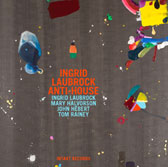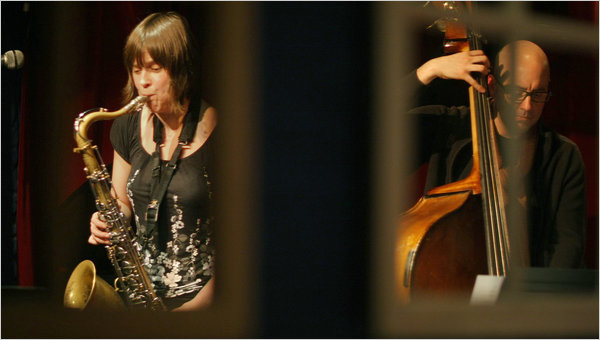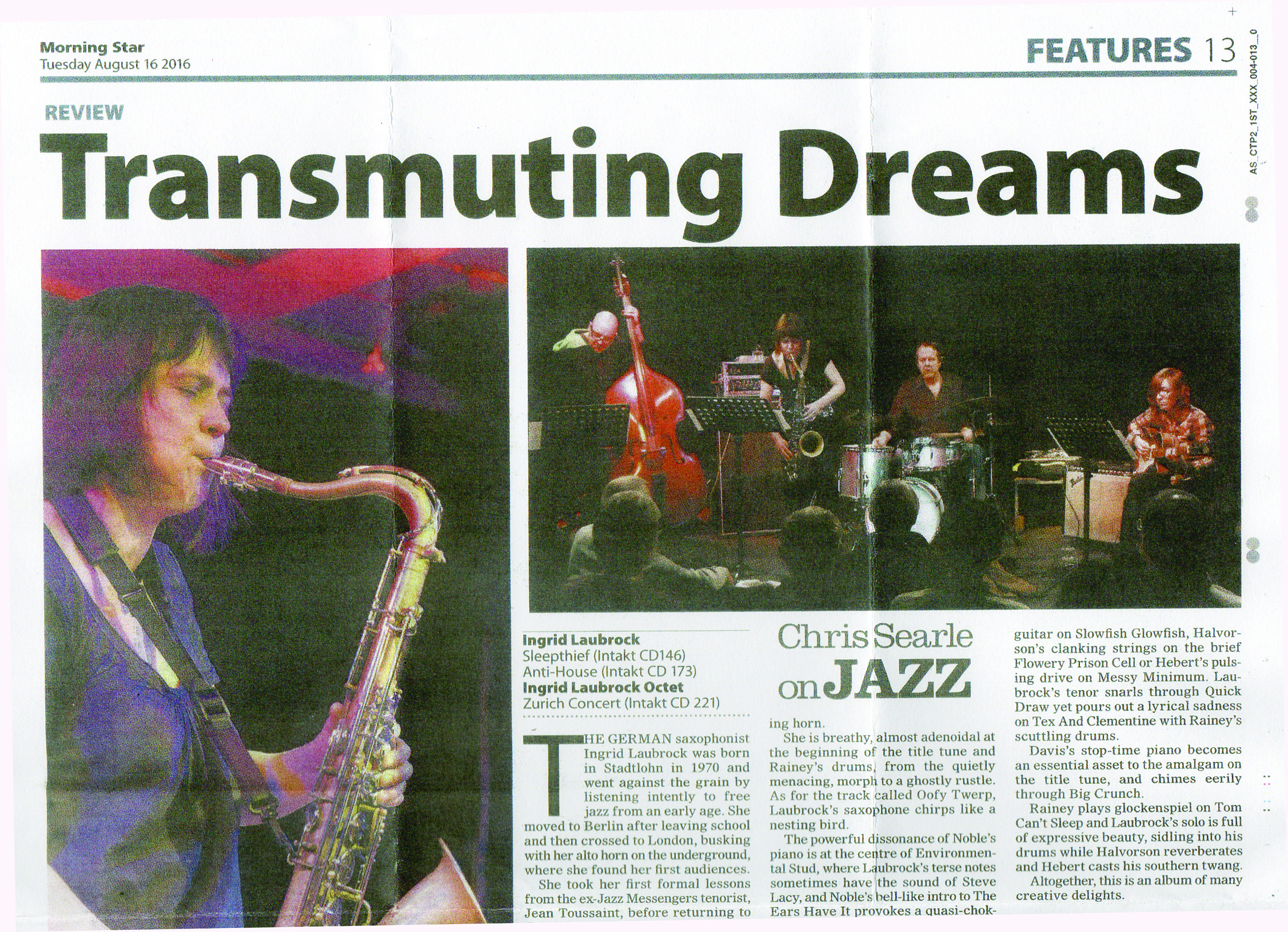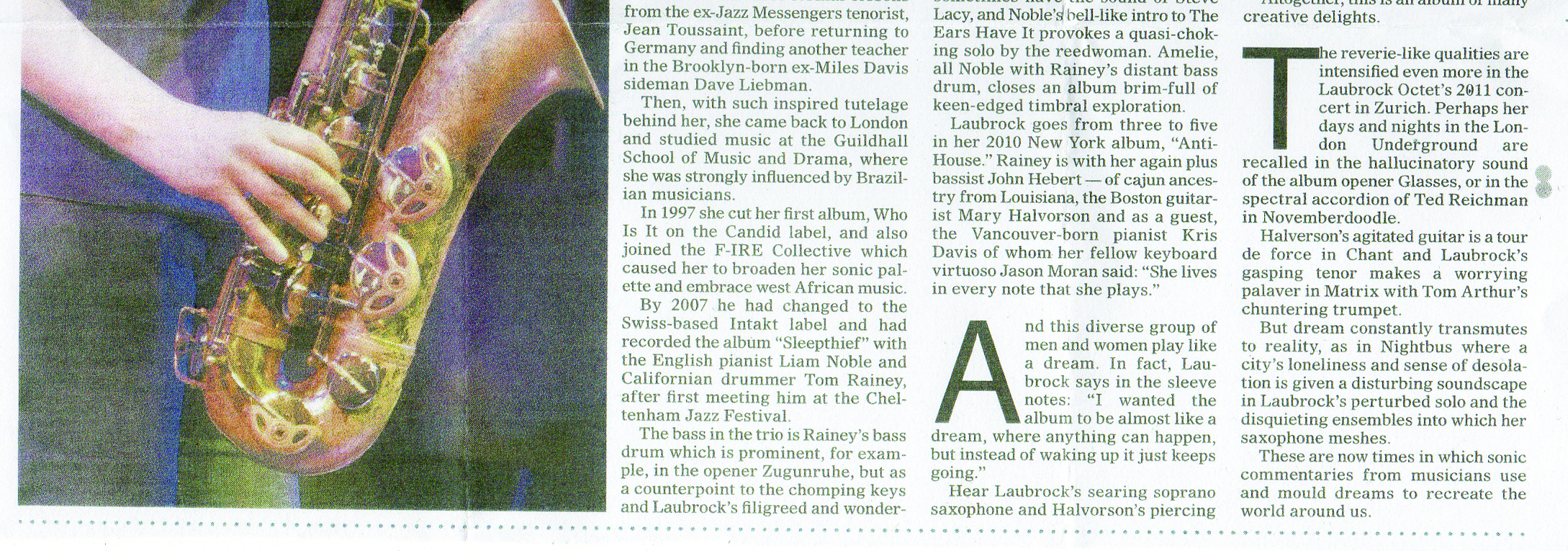INTAKT
RECORDS –
CD-REVIEWS
INGRID
LAUBROCK ANTI-HOUSE
Intakt CD 173

|
German saxist
Ingrid Laubrock, a creative presence on the London contemporary jazz
scene since the 1990s, has moved to New York, and the impact on her
work is palpable. This group, featuring the innovative guitarist Mary
Halvorson (an explorer of experimental rock as well as free jazz), is
more inviting than Laubrock's earlier Sleepthief trio, which also featured
Tim Berne drummer Tom Rainey but had a more clinically investigative
air. Laubrock's expressiveness takes in austere, somewhat contemporary-classical
melodies suggestive of the late Steve Lacy, snorting Evan Parker-like
maelstroms (dynamically partnered by Halvorson in metallic-thrash mode)
and at times a kind of free-grooving postbop. The pieces are short,
varied, and half of them get additional fizz from the dramatic Canadian
pianist Kris Davis. Though some of the motif-swapping strategies sound
a shade robotic, Anti-House is a vivid indication of Laubrock's growing
independence – and Halvorson's Derek Baileyesque scrambling runs,
Hendrix distortions, wild on-the-fly detunings and massaged jazz-guitar
grooves offer constant diversions.
INGRID LAUBROCK
ANTI-HOUSE resultiert aus dem Wechsel der Saxophonistin von London nach
New York. Ihr Quartett mit Mary Halvorson an der Gitarre, John Hébert
am Bass und Tom Rainey an den Drums wird bei einigen der Stücke
des Debuts (Intakt CD 173) noch durch ihre Stone-Trio-Partnerin Kris
Davis am Piano erweitert. Laubrocks Vorstellungen sind stark genug,
um den Geist von Sleepthief (ebenfalls mit Rainey, ebenfalls auf Intakt)
mit über den Atlantik zu nehmen. So erklingen neben sprunghaft
munteren und, vor allem von Halvorsons lehrbuchwidrigen Saitentraktaten,
ungeniert angeschrägten Tönen auch wieder solche, die, Laubrock-typisch,
nachdenklich das Kinn aufstützen. Meist kollidieren beide Seiten
innerhalb der 6, 7 Minuten, in denen sich viele der Stücke entfalten.
Daneben gibt es kurze Kollektivimprovisationen als solche oder als geräusch-
und seltsamkeitsverliebte Intros zu den Kompositionen. "Funhouse
Clockwork" mit Glockenspiel von Rainey macht loses Gepinge und
geräuschhafte Kürzel einfach zum Gestaltungsprinzip. Kühl
und sparsam Abgeklärtes und problematische Ungradlinigkeit gehen
Hand in Hand, vereint in spröder Poesie. Davis streut dazu ganz
kristalline Klangpartikel, spitzfingrig flink. Rainey klickert und kleckert
perkussiv, quick, allenfalls fragmentarisch, was Rhythmik angeht, aber
vieltönig rollt und wuselt er durch verwinkelte Fluren und treppauf-treppab.
Bei Anti-House sind die Dimensionen wie von Maurits Cornelis geEschert.
Laubrock fand für diese Insichwidersprüche poetische Namen:
"Messy Minimum", "Mona Lisa Trampolin". Auf den
kurzen Kladderadatsch "Big Bang" folgt der Beinahestillstand
"Big Crunch". "Betterboon" wechselt in sich von
Sopranomondstich zu ostinaten Stupsern und Gitarrennoten, so krumm wie
verbogene Nägel. "Tom Can"t Sleep" beginnt als Glockenspielwiegenlied,
das einem allerdings die Augen so sperrangelweit aufreißt, dass
man sich gleich wieder ins Nachtleben stürzen und von Halvorson
das Fell aufrauen lassen kann. Ihre verzogenen Töne lassen bei
"Oh Yes" nochmal die Fetzen fliegen, "Mona Lisa"
zwirbelt nach einer langen Denkpause ihren Dali-Schnurrbart zu Glockenspiel,
Schrottgerappel, freigeistigem Getröte und Geplinke. Wie könnte
man dieses Lächeln nicht erwidern?
Ivan Hewett, The Daily Telegraph, Great Britain, October 2, 2010
Her music has grown exponentially
in the intervening years, but there are passages on saxophonist Ingrid
Laubrock's Anti-House which resonate strongly with her 2004 album, Forensic
(F-IRE), the disc which announced her emergence as a soloist and bandleader
of propitious substance and originality. The connection is the beat.
Until now, Laubrock's post-Forensic albums, notably Sleepthief (Intakt,
2008) and Paradoxical Frog (Clean Feed, 2010), have found her more involved
with sonic experimentation on her horns, and in-the-moment micro-interaction
with her fellow musicians, than with the loved up, serpentine grooves
and ostinatos she engaged in with bassist Larry Bartley and drummer
Tom Skinner on Forensic—and perhaps even more memorably when playing
the album's book live, with Sebastian Rochford in the drum chair.
Die junge, ursprünglich
aus Deutschland stammende, dann jahrelang in England lebende und jetzt
in Brooklyn beheimatete Saxofonistin ist auf dem besten Weg, ein Star
in diesem Nischenbereich des Musikbusiness zu werden. Sie wird zu Festivals
eingeladen, bringt regelmäßig neue Tonträger heraus
und wird auch bei fremden Projekten gerne als Gast eingeladen. Die feine
Band, die bei ‚Anti- House‘ dabei ist, hilft das Vehikel
in die Höhe zu bringen (fantastisch: Tom Rainey mit seinem einfühlsamen
und doch die Sache vorantreibenden Spiel!, Mary Halvorson produziert,
hörbar an Ribot & Chadbourne geschult, Seiten- und Aufwinde
für die Flugfähigkeit, mit ihren bizarren akustischen Einwürfen
und John Hébert, das Gefährt ist ja schon flugfähig
in der Luft, sorgt dafür, dass es nicht abstürzt, indem er
es mit fetten, den Boden verachtenden Grundtönen ausstattet). Laubrock
spielt solide und hat die Abgeklärtheit eines alten Profis, der
nicht altruistisch angekränkelt ist. Viel Glück!
Pirmin Bossart, Kulturtipp, Schweiz, Herbst 2010
Ingrid Laubrock's trajectory
through the music reflects her choice of home. German-born, when she
resided in London she was producing Latin jazz, but that proved to be
only a passing phase. By the time of Forensic (F-IRE, 2004), it was
clear that she was more intent on carving out an idiosyncratic space
of her own. Now, having moved to New York, she's dealing exclusively
in more demanding music, as this release exemplifies.
Martin Schuster, Concerto, Österreich, Oktober/November 2010
Andy Hamilton, The Wire, London, October 2010
Hening Bolte, Jazz, The Netherlands, Herbst 2010
Tom Gsteiger, St. Galler Tagblatt, 6.Oktober 2010
Playlist
A young German jazz saxophonist
who stole into New York a few years ago, Ms. Laubrock has just recently
made her presence known. On “Anti-House” (Intakt) she leads
a quartet with the anchoring bassist John Hébert, the rough-colorist
drummer Tom Rainey and the one-of-a-kind electric guitarist Mary Halvorson,
who here plays some of her most caustic and overdriven improvising.
(The pianist Kris Davis is in there too on some tracks.) Ms. Laubrock
has authority in her sound, on tenor and soprano, but she doesn’t
use it to reassure or soothe you. This record would be a good blindfold
test: With no knowledge of her past, you might guess that she did not
learn jazz from black American jazz musicians of an older generation.
There is not a lot of what most people call swing in here. But you can’t
tell how old she is, where she’s from, whose records she owns.
Mark Keresman, ICON, Chicago, October 2010
Christoph Wagner, WOCHENZEITUNG, Zürich, 14. Oktober 2010
John Sharpe, All About Jazz New York, December 2010
Selwyn Harris, Jazzwise, GB, Dez 10/Jan 11.
German tenor and soprano saxophonist Ingrid Laubrock has, especially through her association with drummer Tom Rainey, become a regular in the New York improvising milieu. As such, her latest group also includes Rainey, guitarist Mary Halvorson, pianist Kris Davis and bassist John Hébert, all of whom are among the leading lights of contemporary music in the city. Of the disc's fourteen cuts, nine are Laubrock's own, which on paper might not be all that surprising but upon hearing them, their openness seems to operate in an area quite removed from "fly shit on paper." Overall, the saxophonist's playing has a fuzzy slink and exhibits a penchant for bunched rhythmic gobs, sly shifts that ensure the compatibility of someone like Halvorson, and Laubrock's group concept also necessitates that she often guides without playing. That said, her dynamic range is pretty staggering, moving from low blat to high-pitched screech, vocalizing though the horn and plying cool, boppish runs, all with a low heat that seems to encapsulate both 'micro' and 'macro' improvisational languages.
Bill Meyer, Downbeat, Great Britain, February 2011
Twee jaar terug verraste Ingrid Laubrock met de zeer sterke plaat Sleepthief. De van oorsprong Duitse saxofoniste is via een jarenlang verblijf in Engeland in de Verenigde Staten aangeland waar ze in elk geval een vruchtbare samenwerking met de meesterlijke drummer Tom Rainey tot stand heeft gebracht. De twee speelden samen op Sleepthief in Raineys trio Pool School en nu dan in Anti- House waarin ook gitarist Mary Halvorson opduikt, de derde musicus uit Raineys trio. Halvorson is met haar uitgebeende geluid en rafelige spel meteen degene die de sound van Anti-House in belangrijke mate bepaalt. Net als SleepThief bevat Anti-House weergaloze vrije jazz. Fantasierijk, krachtig maar subtiel en met soepele geestdrift uitgevoerd. Helaas geldt dat niet de hele tijd. Er staan ook losse flodders op, spanningsloze experimenten waarin er niets op het spel lijkt te staan. Daarmee ondergraaft de groep eigenhandig de kracht van deze plaat die met een strengere songselectie moeiteloos hoog in de jaarlijstjes had kunnen scoren.
Zum Abschluss nun endlich etwas Neues: die neue Band der hiesigen Saxofonistin, die 2008 von London nach NY rübermachte, ist, was zeitgenössischen Jazz angeht, definitiv auf der richtigen Seite und der Höhe der Zeit: eine stimmige und selbstverständliche ergo komplett unangestrengte Dialektik aus Improvisation und Komposition, die natürlich bei aller überkomplexen Vertracktheit schön fließt und nicht blödsinnig störrisch hakt, traumwandlerische Sicherheit in den größten Abstraktionen und klare Konzepte in den kleinsten Konkretionen. Nur eine etwaige tatsächliche Abneigung gegen House-Musik könnte hier natürlich empfindliche Abzüge in der Gesamtnote bewirken, wahrscheinlicher aber ist der Bandname als Bekenntnis zur Weisheit des offensiven Nomadentums zu verstehen: feste Prinzipien und Charakterstärken haben, aber die Heimat eher als relativ betrachten. Dass das Geschlechterverhältnis dieser Combo, und es ist endlich mal wieder eine, solide ausgewogen ist, kann erwähnt werden, auch, dass die andere weibliche Hälfte dieses famosen Quartetts Mary Halverson ist, die - bekanntlich selbst bestens zentriert und Bandleaderin - eine klare Klasse für sich bildet (und deren Gitarre ebenso komplex-klar wie auch mal herzhaft-heftig verzerrt auftischen kann), und auch die exorbiante Zeitökonomie der insgesamt 14 (!) Stücke sollte nicht unerwähnt bleiben: nur das Titelstück erreicht knapp 10 Minuten, der Rest weiß sich vorbildlichst einzuteilen, zu be- und entspannen und ohne viel Aufhebens auch wieder loszulassen. Keine wirklich einfache Kost, soviel sei natürlich gewiss, aber in jeder Hinsicht ein Gewinn. Ein besserer, als viele Krisengewinnler uns jetzt schon wieder glauben machen wollen, und ein Hörfest, dass jedes systematische Fiebertrauma ernüchtern und abkühlen kann.
Michael Rosenstein, Signal to Noise, USA/Kanada, Winter 2011
Jan Granlie, Jazznytt, Norway, desember 2010 - januar 2011
Konzerbesprechung, Bad Alchemy Nr. 68, Deutschland, Winter 2010/2011
Christoph Wagner, Neue Zeitschrift für Musik, Deutschland, Januar 2011
Ingrid Laubrock's Anti-House, Vortex Jazz Club, London Ever since Laubrock relocated from London to New York City in 2008, she has become one of the rising stars of the scene, having fallen in with a coterie of like-minded individuals centered around Brooklyn. That's borne out by her appearance on a welter of discs in 2010, including fine performances on the collective Paradoxical Frog (Clean Feed, 2010) with drummer Tyshawn Sorey and pianist Kris Davis, drummer Tom Rainey's leadership debut Pool School (Clean Feed, 2010) along with guitarist Mary Halvorson, and her own sophomore effort on the Swiss Intakt imprint, Anti-House (2010). Almost all the repertoire this night was from that eponymous album, prolonged in the concert setting but similarly, deliciously obtuse. Appearing alongside the saxophonist in Anti-House, in addition to Rainey behind the traps, were everyone's favorite guitarist Halvorson, now a feted leader in her own right with her Saturn Sings (Firehouse 12, 2010) prominent on many best-of-year lists, along with the guitarist's bassist on that recording, John Hébert. Laubrock's tenor saxophone distortions were paired with Rainey's brush-stroked drums to open the first set, before being intersected by an angled guitar and bass figure. Then it was back to the initial twosome, with reiterated motifs from the saxophonist and Rainey striking his drum set with his hands as the piece took shape as a duet with interjections. So it went, with brief unison passages or snatches of rhythm or melody interpolated into more abstract, seemingly improvised, colloquy. It would be pointless to describe the myriad twists and turns inherent in each installment. It was cerebral, poised and taut, but also at times calling down all the visceral clout of Sixties fire music. As with the studio disc, part of the fascination, in addition to the stellar playing, resided in listening to the episodic written structures and detecting when they had been jettisoned. Live, even among the odd emphases and accents, it was obvious that the charts played a large part. Typical of the stark contrasts and juxtapositions, the fourth number alternated lyrical rumination and heavy metal skronk with Rainey smiting his kit with relish, before, as with many of the segments, drawing to a low-key close. Not only did the whole quartet prove to be astute readers (and they needed to be, as some of the compositions stretched across three taped-together pages), but they were also fantastic improvisors, able to switch between the two states in the blink of an eye, seamlessly moving in and out of intricate fast unisons in varied combinations. Even though solo and duo features emerged, they were used as an integral part of the proceedings rather than as blowing opportunities. Overall the level of musicianship was breathtaking. It was a pleasure to study Halvorson's work at close quarters. Combining scratchy plucking with effects pedals to conjure whirling comet tails of sound, she evoked thoughts of an unholy alliance between Jimi Hendrix and Joe Pass. Her dexterous runs, bent grace notes and single note tremolos meant that she was always a focus of attention even when the main action was supposedly elsewhere. Hébert was the least demonstrative of the four, but still on the money, forming the golden thread which tethered the quartet together in the ensembles, whether with elegant pizzicato or velvety arco textures. But he was also adroit in the foreground, enjoying a responsive duo with Halvorson on "Quick Draw," and later taking a swinging solo on "Tom Can't Sleep." Rainey was a revelation. His prowess is well known, but it was nonetheless an education to witness how he not only rendered odd timbres with exactitude, but how he then assembled them into bursts of off-kilter swing. When needed, he manifested a controlled ferocity, as with his whipcrack interjection on "Quick Draw" heralding the knotty theme. Whether circling explosive patterns around his drum set, sizzling on cymbals or rubbing his wetted fingers across his drum heads for a booming sigh, he combined power and precision in one casually virtuosic package. Laubrock shone even in this company. Although capable of breathy asides which would have pleased Ben Webster, she displayed a fondness for the sort of distorted tones which might have caused him to look rather more askance. Here she mixed false fingered shrieks with muffled cries and even stranger strategies, as when she removed the neck from her horn and blew directly into the body for a whooshing whistle, only to deftly replace the neck and mouthpiece for the next section. While she can shriek and overblow with the best, it seemed that this was just one more style deployed when required, rather than the default mode. Special guest pianist Liam Noble joined for the third number, adding another layer to the absorbing complexity, taking the role filled by Canadian pianist Kris Davis on the group's CD. His inventive piano thickened the arrangements and extended the textural range, as when he answered Rainey's silvery tinkling glockenspiel with plucks on the piano strings on "Funhouse Glockwork." Unfortunately, I had to leave for the last train after just one piece from the quintet, but the show was recorded for BBC Radio 3, so there may yet be chance to taste what I missed as well as savor what I heard. And that would be very good, as this was a performance which could bear repeated listening.
Artikel über Ingrid Laubrock, Hans-Jürgen Schaal, Jazzthetik, Deutschland, Mai/Juni 2011
Goncalo Falcão, jazz.tp, Portugal, julho / agosto 2011
Ingrid Laubrock, sassofonista nata in Germania ma con all'attivo importanti esperienze in seno al circuito della musica improvvisata londinese, nel 2008 è approdata a New York e questo eccellente lavoro testimonia i risultati dei suoi nuovi contatti, maturati dopo mesi passati ad ascoltare dal vivo i suoi colleghi nella metropoli americana.
Portrait of Mary Halvorson, THE NEW YORK CITY JAZZ RECORD, October 2011, USA
Portrait über Ingrid Laubrock, Christoph Wagner, Jazzpodium, November 2011, Deutschland
MUSIC REVIEW | INGRID LAUBROCK
Chris Searle, Morning Star, August 16, 2016
|
 Chang W. Lee/The New York Times
Chang W. Lee/The New York Times 
